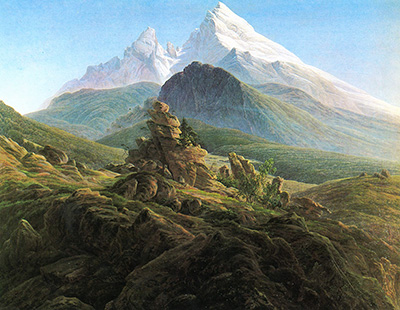The Watzmann, also known as Der Watzmann in German, is oil on canvas painting painted in 1824-1825 by Caspar David Friedrich. The portrait shows the Watzmann Mountain as seen from the north-east, especially Berchtesgaden municipality.
This unique, hieratic mountain landscape drawing may have been anticipated to rival the landscape painting done by the leading Italian master, Ludwig Richter as well as other German artist works. However, the title of the canvas is somehow confusing since, besides the Watzmann itself, Friedrich incorporated immediately identifiable themes from other distinctive mountain ranges. In the foreground, you will see the unique shapes of rocks, while the massive crag in the Harz Mountains, famously known as Erdbeerkopf is recognisable from the middle distance. Friedrich had never seen Watzmann before, but he utilised a watercolour sketch of 1821 to draw the peak of this particular mountain.
David Friedrich first exhibited this painting in the yearly Dresden art exhibition of 1825. The Watzmann drawing alongside the Die Hochgebirge are among the largest paintings of his whole career and his only well-known demonstrations of the Alps. To Dresden’s connoisseurs, who by the 1820s had learned to anticipate from Caspar the rocky coasts, the forests of northern Europe, and moonlit skies, these two unique mountain scenes came as a surprise. David’s fanatics wondered why he shifted from his typical subject matter, whereby his earlier landscapes had always replicated his straightforward experience of nature. In fact, Friedrich was one of the limited landscapists of that time who had never visited the Alps. His unwillingness to travel to the south was recognised in Dresden’s art circles.
In theme and size, Caspar’s portraits are exclusive within his work. When viewed against the role Mountains were given in those days and the background of geognostical theories of earth’s history, David’s canvases are identifiable as a hymn to the general laws of the formation of mountains. Together, they join to become accessories that represent the tenets of geognostical literature. The motivation behind Caspar’s sudden move was an aspiration to produce creative work to the forces that had shaped and created the earth’s crust.
The Watzmann painting makes Caspar Friedrich one of the best landscape portraitists of German Romanticism. In this painting, David expresses the fresh perception of nature during Romanticism through means of his contemplative and emotional way of looking at nature. Alongside Phillip Otto Runge, Friedrich was part of the Dresden Circle that also included the poets Novalis and Ludwig Tieck.
This painting shows a world without limits, an eternity of nature which human beings can only clasp with their inner emotions. The light, shadow, as well as simplicity and depth of the colours, emphasize the symbolic message of Caspar soulful portraits. The Watzmann by Friedrich isn’t an ordinary filler painting that is just placed on a wall. It provides a great way to brighten up a place or offer distraction and comfort depending on the environment. When placed on a wall, this special landscape drawing can change the whole look of a place that was otherwise uninteresting.




